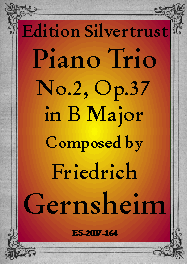Presents
Friedrich Gernsheim
Piano Trio No.2 in B Major, Op.37
 "Gernsheim's
masterly piano trios unquestionably, along with most of his other chamber music,
belong in the repertoire. Once the public rediscovers them, that should happen."
So wrote the editor of The Chamber Music Journal.
"Gernsheim's
masterly piano trios unquestionably, along with most of his other chamber music,
belong in the repertoire. Once the public rediscovers them, that should happen."
So wrote the editor of The Chamber Music Journal.
Friedrich Gernsheim (1839-1916) is a composer whose music was held in the highest regard by critics during his lifetime. No less an authority than Wilhelm Altmann, perhaps the most influential chamber music critic of all time has written that Gernsheimís chamber music is poetic and of a high intellectual content. But Gernsheim had two misfortunes, which led to his music not obtaining the reputation it might have. The first was to be born within 6 years of Brahms. A misfortune because, in what is surely an extraordinary phenomenon, virtually every composer in the German-speaking countries born within a decade either side of Brahms were so eclipsed by him that their reputation and music all but disappeared when that era was over. Names such as Rheinberger, Reinecke, Kiel, Bruch, Dessoff, and Herzogenberg, among many others, come to mind. The second misfortune was that being Jewish, his music was officially banned during the Nazi era, which insured that it would fall into oblivion. It is only now, close to a century after his death that it is being rediscovered with great delight.
Gernsheim, somewhat of a piano and violin virtuoso as a child, was eventually educated at the famous Leipzig Conservatory where he studied piano with Ignaz Moscheles and violin with Ferdinand David. After graduating, he continued his studies in Paris getting to know Saint SaŽns, Lalo, Liszt and Rossini. Despite his admiration for France and the French, he returned to Germany and during the course of his life, he held academic and conducting positions in Cologne, Rotterdam and finally Berlin. He used his position as a conductor to advance the cause of Brahmsí music. The two, while not close friends, carried on a correspondence for many years during which it was clear that Brahms had considerable respect and admiration for Gernsheimís work. An accolade which was, in Brahmsí case, no mere flattery as Brahms only very rarely praised the works of other composers.
The Second Piano Trio dates from 1879. He had by then obtained his own voice and had freed himself from the influence of Mendelssohn, Schumann and even Brahms whom he admired. The trio is full of wonderful melodies and original ideas. It can stand on its own in the front rank of this genre and was much admired from the time of its premiere onward. The opening Allegro moderato begins with a highly romantic love theme, perhaps in part because the trio was dedicated to his wife. The second theme is more somber and more reflective. The quite original second movement, Vivace, is a playful scherzo. The slow movement, Lento e mesto, as one would expect from the title, slow and sad. The lovely and moving melody quite clearly is a funeral dirge. The part writing is extraordinarily fine and effective. The triumphant finale, Allegro non troppo ma energico, dispels the mood of sadness and brings with it a compelling joie de vivre.
Parts: $29.95